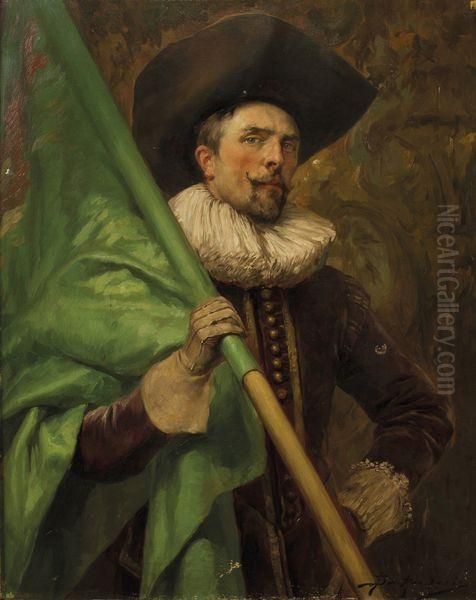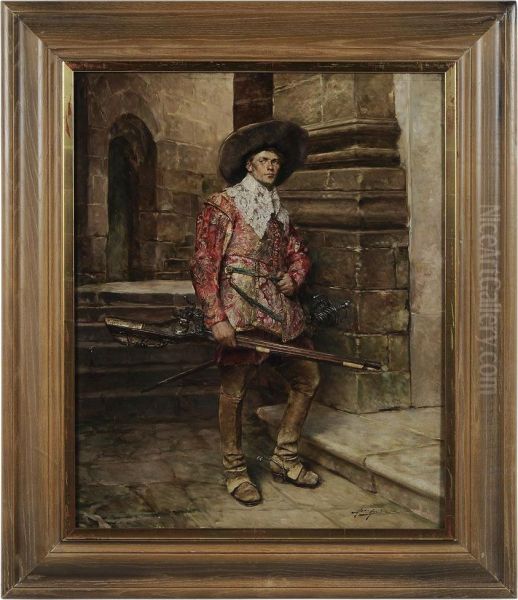Alex De Andreis stands as a notable figure in early 20th-century Belgian art, celebrated for his evocative depictions of historical scenes, primarily drawing inspiration from the 17th and 18th centuries. Born in 1880 and passing away in 1929, De Andreis carved a niche for himself with paintings that captured the spirit, costume, and atmosphere of these earlier periods. His work, characterized by a distinctive blend of technical skill and decorative flair, continues to attract interest from collectors and art enthusiasts alike, offering a window into a romanticized past filled with cavaliers, elegant interiors, and moments of historical drama.
Biographical Sketch
Available records indicate Alex De Andreis was born in Bruges, Belgium, in 1880. Unlike many artists whose lives are extensively documented, specific details about De Andreis's personal life, training, or formative experiences remain relatively scarce in easily accessible historical accounts. The primary focus of his legacy lies firmly in his artistic output. He dedicated his career to painting, developing a style that resonated with audiences who appreciated historical themes rendered with painterly skill. His lifespan places him within a period of significant artistic change, yet he remained committed to a form of historical genre painting that had found favour in the preceding century. He passed away in 1929, leaving behind a body of work that continues to define his contribution to Belgian art.
Artistic Style and Technique
The hallmark of Alex De Andreis's art is his focus on the 17th and 18th centuries. His canvases are populated with figures dressed in the elaborate costumes of these eras – musketeers, cavaliers, elegantly attired ladies, and soldiers. He often set these figures within atmospheric interiors, such as dimly lit taverns, opulent palace rooms, or guardrooms. His approach was not one of strict historical reconstruction but rather an evocation of mood and character.

De Andreis wielded his brush with notable confidence and elegance. His technique is often described as firm yet fluid, allowing him to render textures like velvet, silk, and steel with convincing realism while maintaining a painterly quality. A key feature of his style is his adept use of light and shadow, often employing chiaroscuro effects to heighten the drama and focus attention on key elements within the composition. This interplay of light imbues his scenes with a tangible atmosphere, whether it's the warm glow of a tavern hearth or the cool light catching the surface of armour. His colour palette was typically rich and vibrant, contributing to the overall decorative appeal of his works.
Themes and Subjects
De Andreis consistently returned to a set of favoured themes throughout his career. Portraits of solitary figures, particularly musketeers or cavaliers, are prominent. These figures are often depicted in moments of contemplation, readiness, or quiet confidence, their elaborate attire rendered with care. The Musketeer (Le Mousquetaire) appears as a recurring subject or title in his oeuvre, capturing the romantic image associated with these historical figures popularized by literature.
Beyond single figures, De Andreis excelled at multi-figure compositions. Tavern scenes, showing soldiers or gentlemen relaxing, playing cards, or engaged in conversation, were common. He also depicted more refined settings, such as groups gathered in well-appointed rooms, perhaps examining objects of art, playing chess, or engaging in aristocratic pursuits. Scenes featuring soldiers, sometimes in armour or uniform, were another staple, with titles like On Guard suggesting themes of duty and readiness. These thematic choices reflect a fascination with the social customs, attire, and romantic archetypes of the 17th and 18th centuries. His paintings invite viewers to imagine the lives and stories behind the historical facade.
Representative Works
While a comprehensive catalogue raisonné might be elusive, certain works and themes are consistently associated with Alex De Andreis. As mentioned, depictions titled The Musketeer or Le Mousquetaire are central to his output. These paintings typically feature a male figure in 17th-century attire, often showcasing De Andreis's skill in rendering costume and capturing a sense of character through pose and expression. One known example, identified as Le Mousquetaire, is an oil on wood panel measuring approximately 45 x 29 cm, dating likely from the late 19th or early 20th century and held in a private collection in Paris.

Works featuring cavaliers, often in rich attire and sometimes depicted admiring art or engaged in leisure activities like chess, are also representative. Paintings capturing the camaraderie or tension within tavern or guardroom settings further exemplify his thematic interests. The title On Guard points to his depictions of soldiers, emphasizing their watchful or poised stances. His portrayals of women in elegant 17th or 18th-century dress also form part of his known work, showcasing a softer, though equally decorative, aspect of his art. These representative themes highlight his consistent engagement with historical genre subjects and his ability to create visually appealing and atmospheric compositions.
Artistic Context and Influences
Alex De Andreis worked during a time when academic and historical painting traditions, though challenged by modernism, still held considerable sway, particularly in certain markets. His focus on 17th and 18th-century themes places him within a lineage of artists fascinated by historical revivalism. While direct interactions with specific contemporaries are not well-documented in the provided sources, his work can be understood in the context of broader European artistic trends.
The meticulous historical detail and dramatic flair in some 19th-century painters, such as the French artist Jean-Louis-Ernest Meissonier, known for his incredibly detailed Napoleonic and 17th-century scenes, set a high bar for historical genre painting. While De Andreis's style was generally broader and more atmospheric than Meissonier's minute precision, the shared interest in historical accuracy and narrative is evident. The vibrant colour and painterly energy seen in the work of Spanish artist Mariano Fortuny, who also tackled historical and Orientalist themes, might offer another point of comparison, although Fortuny's style was uniquely brilliant.
De Andreis's handling of interior scenes and light effects inevitably recalls the Dutch Golden Age masters of the 17th century, such as Gerard ter Borch or Gabriel Metsu, who excelled at depicting textures and intimate domestic settings. Although De Andreis's approach was filtered through a later sensibility, the influence of these earlier masters on the composition and lighting of genre scenes is a recurring theme in Western art. His confident brushwork, particularly in rendering figures, might distantly echo the bravura of painters like Frans Hals or even Velázquez, though applied to different ends.

The elegance and decorative quality in some of his depictions of figures in costume could also loosely connect to the spirit of 18th-century French painters like Jean-Antoine Watteau or François Boucher, albeit without their specific Rococo lightness. Closer to his own time, the interest in historical settings was shared by artists like Lawrence Alma-Tadema, who focused on classical antiquity, or fellow Belgian Henri Leys, who looked towards the Northern Renaissance and Baroque periods. Even the dramatic use of light and shadow (chiaroscuro) fundamentally owes a debt to Baroque masters like Rembrandt. De Andreis synthesized these historical echoes into his own distinct, accessible style, focusing on romantic atmosphere rather than strict archaeological accuracy or profound psychological depth.
Reception and Legacy
During his lifetime and in the decades following his death, Alex De Andreis's paintings found a ready market. Their decorative quality, combined with the romantic appeal of historical subjects, made them popular choices for collectors. His works were appreciated for their technical proficiency, particularly the confident brushwork and effective use of light and shadow, which brought his historical vignettes to life. The elegance and atmospheric charm of his scenes resonated with audiences seeking visually pleasing art that evoked a sense of nostalgia or historical fantasy.
Evidence of his continued market presence includes auction records, such as a sale at Sotheby's in London in May 1998, where a work depicting women in 17th and 18th-century costume was sold. His paintings are often described as valuable collector's items. While perhaps not considered a major innovator in the broader history of art, De Andreis successfully catered to a specific taste for well-executed historical genre painting. His legacy lies in his contribution to this genre, creating a body of work characterized by its consistent style, thematic focus, and enduring decorative appeal. He remains a recognized name among specialists and collectors interested in Belgian art of the period and the tradition of historical painting.
Conclusion
Alex De Andreis was a skilled Belgian painter who dedicated his career to capturing the essence of the 17th and 18th centuries through his art. Working in the early 20th century, he developed a distinctive style characterized by elegant, confident brushwork, a masterful use of light and shadow, and a focus on historical costumes and settings. His subjects – cavaliers, musketeers, tavern scenes, and elegant interiors – were rendered with an atmospheric quality that appealed to the romantic imagination of his audience. While details of his personal life remain limited, his artistic output clearly defines him as a proficient and popular exponent of historical genre painting. His works, such as those titled The Musketeer and On Guard, continue to be appreciated for their decorative qualities and technical skill, securing his place as a notable, if specialized, figure in the history of Belgian art.